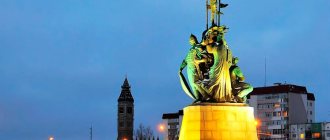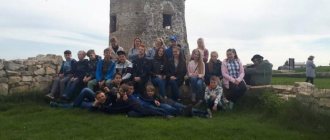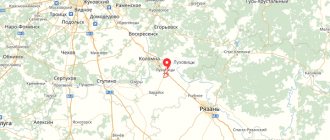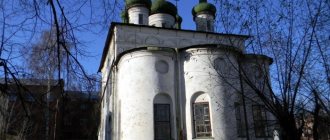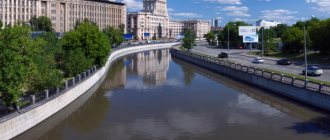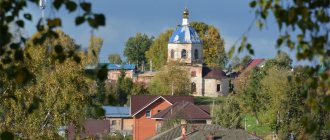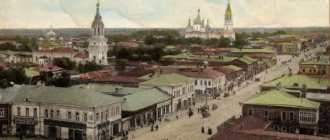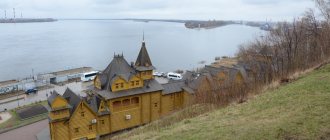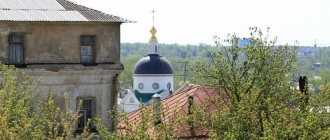Syzran is a city in the Samara region, located on the right bank of the Volga, at the confluence with the Syzranka River. This is a small city with a population of only about 173 thousand people. At the same time, the majority of indigenous Syzrans consider themselves direct descendants of the Rurikovichs.
Syzran is famous for its architectural monuments, which miraculously managed to survive the fire of 1906, which caused significant damage to the settlement. Thanks to this, the city has still retained the spirit of the bourgeois-merchant environment.
- What not to miss when traveling around Syzran: in our review of the most important places in the region.
- You can get to Syzran from Samara (city guide) - by car in three hours, and from April to September inclusive by high-speed ship "Voskhod" along the Volga in 2 hours 15 minutes.
City of Syzran
Its favorable geographical location at the crossroads of trade routes made the city a regional trading center. Grain was brought to Syzran for sale and herds of animals were brought in. In 1780, Empress Catherine II established the coat of arms of the city of Syzran - a black bull on a golden background. After the banks of the Volga were connected by the Alexander Bridge, Syzran became a major railway junction on the way from Europe to Asia.
Federal and intermunicipal highways pass through Syzran:
| Direction | Significance |
| Moscow/Samara/Chelyabinsk | Federal route |
| Syzran/Ulyanovsk | Federal route |
| Syzran/Volgograd | Interregional route |
Distance to cities:
- Moscow —890 km;
- Samara - 169 km;
- Ulyanovsk —148 km;
- Volgograd —684 km.
In the 20s of the last century, extensive oil and oil shale deposits were discovered around Syzran, which made the city a second Baku. Modern Syzran is inhabited by 174,000 inhabitants; it is a large industrial and cultural center of the Samara region.
The Syzran Higher Military Aviation School is the only center in Russia for training flight personnel of helicopter units of the Russian Aerospace Forces. Not only Russians, but also citizens of other countries are trained within its walls. The Syzran school of icon painting, restored in 1999, was known back in the 19th century, thanks to the artist A. A. Bochkarev (1866-1934).
There is an icon-painting workshop at the school; orders for icons of the “Syzran letter” are accepted. Within the city there are a lot of green parks, boulevards and a large number of public gardens.
Four small rivers flow through the territory of the Syzran urban district:
- Syzranka;
- Kubra;
- Casing;
- Crimea.
The total area of the waterways is 505 hectares. City water supply provides citizens with high quality drinking water. Every year at the end of summer, the “Silver Trumpets of the Volga Region” music festival is held in Syzran, in which brass bands and soloists from all over Russia, as well as countries near and far abroad, take part.
Syzran, whose attractions are not only of an architectural and historical nature, presents in the park, on the central street of the city, a monument to the main character of another local festival. The second significant event that takes place in August every year is the Syzran Tomato gastronomic festival.
Climatic conditions and fertile soil contribute to a rich tomato harvest in this region. The tomato has long become a kind of calling card of Syzran. The city is famous for its confectionery products. The “Cobweb” cake was invented by local chefs back in 1927; its recipe is still kept secret.
History and symbols of the city
Syzran was founded in 1683. Although archaeologists have established that the local lands were inhabited 3-3.5 thousand years ago. This was facilitated by a favorable climate and the presence of a large river nearby.
The city was built on the banks of the Volga in order to protect Russian trade routes to the east. However, already in the 18th century, the favorable geographical location turned Syzran into a major center of trade and crafts. In the next century, the flour milling industry also developed in the city. At one time, Syzran was one of the three leaders of the empire in grain processing.
At the beginning of the twentieth century, Syzran experienced an industrial revolution, and during the years of Soviet power, the city, thanks to the oil deposits found here, was called the “second Baku.” A plant for processing oil shale was also built in Syzran, the products of which were popular in many countries of Europe and Asia.
The modern coat of arms of Syzran was approved back in 1780 by Tsarina Catherine. On a golden shield, a black bull proudly walks along a green hill, personifying wisdom, prudence and honesty. The city also has its own flag with an identical image.
Top 10 most interesting sights of Syzran
The Alexander Bridge across the Volga, built in 1880, was for a long time the longest in Europe (1436 m). After the revolution, the Alexander Bridge was renamed Syzransky. The Moscow-Syzran-Samara railway line runs along it.
List of the most interesting attractions:
- Syzran, whose sights can tell about the harsh past of the fortress city, invites you to explore its main historical monument, Spasskaya Tower of the local Kremlin. This is the only fortification structure of the 17th century preserved in the Samara region. Near it is located the no less ancient Church of the Nativity of Christ. Together, the two architectural landmarks form a single composition on the Kremlin Hill.
- Once upon a time, the Syzran fortress, in addition to the stone tower still standing, had four wooden watchtowers . The stone citadel was originally a gatehouse, then its design was changed, and a church was built inside in honor of the Savior Not Made by Hands. Nowadays, the Spasskaya Tower is a cultural and historical object protected by federal legislation. A historical museum is open in the Syzran Kremlin, and at the top of the tower there is a belfry; every morning at 11 o’clock the bell ringer performs a bell concert.
- The Church of the Nativity of Christ was built in 1717 instead of a burnt wooden church; it successfully survived all the hardships and has been preserved in its original form to this day. A flower alley has been planted on the Kremlin Hill. A memorial was built near the Spasskaya Tower in honor of the fallen soldiers.
- Kazan Cathedral in the center of Syzran built in eclectic style. The double-altar church was consecrated in honor of the Kazan Icon of the Mother of God and the blessed prince Alexander Nevsky. The main shrines: the Kazan Icon of the Mother of God, the miraculous icon of the Mother of God, called Fedorovskaya, and the image of St. Nicholas. Address: st. Dostoevsky, 17.
- The Ascension Monastery was founded in 1685. In the Church of the Ascension of the Lord, particles of the relics of ancient and newly glorified saints are kept. The Fedorovskaya church of the monastery houses the main shrine of the monastery - the Fedorovsky image of the Mother of God. On the territory that once belonged to the Ascension Monastery, there is a large residential area of Syzran known as “Mongora”.
- Sovetskaya Street was formerly called Bolshoi Street, and was an unpaved road with wooden sidewalks. At the turn of the 19th and 20th centuries, Bolshaya became the central street of Syzran. The architectural ensemble of the main artery of the city includes a variety of styles: Classical - the First Women's Gymnasium and the Zemstvo Assembly; Eclecticism - a public bank and merchant houses of S. I. Myasnikov and Syromyatnikov; Modern - Sterlyadkin's mansion. Most of the buildings on Sovetskaya Street are included in the list of architectural monuments of the last century.
- In the 19th century, on the site of the current drama theater, the Hermitage summer theater was located. The modern drama theater was officially opened in 1918. In those days, the main part of the repertoire was Russian classics, and performances based on the works of A.N. Tolstoy were often staged. The theater is rightfully considered a cultural symbol of Syzran. Address: st. Sovetskaya, 92.
- Syzran, whose attractions correspond to its geographical location, begins to demonstrate its monuments directly from the platform. The Syzran-1 railway station was restored, after major repairs and reconstruction, in the same form as it was at the time of commissioning in 1874.
- An architectural monument built in the Art Nouveau style of the first half of the 20th century is the mansion of the owner of the first Syzran pawnshop, Pyotr Vasilyevich Revyakin. The house was built in 1908. The unique stucco molding and the girl’s mask on the façade of the building have still been preserved. Address: st. Sovetskaya, 100.
- On Sovetskaya Street there is an unusually colored building with a high spire; this is the former trading house of Permyakova. During its construction, elements of reinforced concrete structures were used for the first time in the city of Syzran. The facade of the house is made in an eclectic style with horseshoes and a wide interfloor belt for advertising signs. The building is an L-shaped building connected by a corner tower with a dome. In the alley there is an entrance arch, and under the building there are large cellars, previously used as storage rooms. Now the city post office and bank branch operate in the former trading building. Address: Sovetskaya, 26.
Temples and churches
Azan Mosque
Address: st. Zhukovsky Phone: , 8 (927) 022‑88-66 Website: https://azan-syzran.ru Opening hours: 09:00 – 08:00 Mon-Sun
The Azan Mosque (the name comes from the Arabic word meaning a call to prayer), which took more than 10 years to build, opened its doors on December 1, 2006 and became a grandiose religious building for Muslims in the Samara region. The prayer room can accommodate up to 400 people, and the height of the building together with the dome reaches twenty-seven meters. Additionally, there are premises for a women's chapel and a Sunday school for children.
Anyone can visit the mosque, even if they are not a devout Muslim. But tourists must follow a number of strict regulations. This is especially true for women: clothing should completely cover the entire body, except for the face and hands, and be of discreet, calm shades. A headdress that completely covers the hair is required. Trousers and makeup are also prohibited.
If a tourist’s clothing does not fully meet the requirements, before visiting the mosque she must take a long skirt and a scarf, which are given at the entrance to Azan.
Men should also dress as closely as possible, but they do not need a hat. According to the rules, you should enter the mosque with your right foot, and leave the building with your left. Shoes are usually removed and left at the entrance.
The Azan Mosque is famous for its spectacular services during the main Muslim holidays, for example, Ramadan, when people professing Islam come to this place not only from Syzran and the Samara region, but also from other regions. Holidays for children are also organized.
Thus, at the beginning of July, the “Farewell to Ramadan” performance is usually held, including competitions, gifts and treats for children. Children's parties are usually attended by guests of honor. In 2021, it was the Mufti of the Samara region, Talip-hazrat Yarullin, who congratulated the younger generation and gave a farewell speech.
Church of Elijah the Prophet
Address: st. International, 12 Phone: , Website: https://syzran-ilii.cerkov.ru Opening hours: 08:00 – 09:30 daily
Initially, at the end of the 15th century, a wooden church was erected on this site on the initiative of three Syzran merchants - Kuropatkin, Pavlyshin and Vandyshev. At that time, in the Middle Volga region there were many Cossacks and soldiers who arrived from other lands and insisted on building a temple for offering prayers. At their request, Syzran merchants began building a church in honor of the prophet Elijah. Later, the descendants of these same townspeople built a stone church in 1776.
After the revolution, the church did not cease to function, but was robbed several times during the Soviet era. In 1940 the church was closed and rebuilt in its building. In 1993, the building was again returned to the Orthodox Church.
Nowadays it is a functioning church, and there is a Sunday school attached to it.
Architectural objects and monuments of Syzran
Syzran (the sights of the city are its entire historical part) is unthinkable without wooden houses decorated with skillful carvings. One of the monuments of wooden architecture is the house of the bourgeois Pozhilova.
Don't miss the most popular article in the section: Metro Nizhny Novgorod. Diagram, map, description.
The untreated wood, dark from time to time, looks like antique silver, the very beautiful openwork carvings, combined with the geometric frame of the windows, make this building an example of a traditional Russian hut. The house was built in 1905, now an ordinary Syzran family lives there. Address: st. Embankment, 55.
Another architectural monument is a wooden building in the Art Nouveau style, which once belonged to the honorary citizen of Syzran E. P. Markushina. The house, painted green with gold trim, is visible from afar. Address: st. Sovetskaya, 87. Syzran hydroelectric power station is another historical and architectural monument. The station on the Syzranka River is the first hydropower facility in the Volga region.
It was launched on November 7, 1929, and is the only dam built as part of the GOELRO plan that has been preserved in its original form from those times. The healing Kashpirovsky spring, located near Syzran, is one of the main places of pilgrimage in the Samara region.
The life-giving power of the holy key has been known for 3 centuries. On the territory around the spring, belonging to the Holy Ascension Monastery, a chapel, an indoor bathhouse and a church in honor of the image of the Most Holy Theotokos “Life-Giving Spring” were built. An ancient well with healing water has been restored and deepened.
Syzran Kremlin
Address: Kremlin Hill
This is one of the main city attractions, which is located at the confluence of the Volga, Syzranka and Crimea rivers. It is the only building of its kind in the Samara region.
The first mention of Syzran dates back to 1683, when Prince Grigory Afanasyevich Kozlovsky began to build a fortress here by order of Tsar Peter Alekseevich (Peter I). The Kremlin was built to strengthen the southern limb of the Samara Luka. In the old days there were five towers here, but the wooden ones were not preserved, only the stone Spasskaya Tower remained.
In 1774, Syzran and its Kremlin were taken by storm by the troops of Emelyan Pugachev. The building was not seriously damaged in the battle.
On the territory of the Kremlin there is another example of ancient Russian architecture - the Church of the Nativity of Christ, and nearby there is a war memorial erected in honor of soldiers who died in local wars.
Historical monuments of Syzran
In 2015, in Syzran, near the Spasskaya Tower of the ancient Kremlin, a monument to the founder of the city, G.A. Kozlovsky, was inaugurated. A little further, along Sovetskaya Street, there is the Square of Glory, where a monument to the citizens of Syzran who became Heroes of the Soviet Union during the Second World War was erected. In Kuznetsky Park in the city center there is a monument dedicated to the heroes of the Civil War.
No modern Russian city can do without a monument to V.I. Lenin. The statue of the leader of the world proletariat rises on Lenin Square, near the drama theater.
SIZRAN
SYZRAN, a city in Russia, in the Samara region, the center of the city district of the same name and the Syzran municipal district. Population 165.2 thousand people. (as of 1.1.2021). Located on the right bank of the river. Volga (Saratov Reservoir), at the confluence of the river. Syzranka. Junction of railways and roads.
Story
Sizran. Spasskaya tower of the Kremlin. 1683. Added to 1755.
Founded in 1683 as a fortified city; The construction was led by the Simbirsk governor, Prince. G. A. Kozlovsky. In 1708–1717 as part of the Kazan province, from 1717 in the Astrakhan province. No later than the 1730s. Syzran district was formed. District town of Simbirsk province. Kazan province. (1737–80), Simbirsk province (1780–1928; until 1796 – Simbirsk governorship, in 1924–28 – Ulyanovsk province). Large shopping center, in the 18th century. 3 fairs were held annually. From ser. 19th century the industry developed, ch. arr. flour milling (in the late 19th – early 20th centuries, the 4th city in Russia in terms of grain processing volumes). Railway traffic is open. lines Morshansk - Syzran (1874), Syzran - Farmers (1877), Ruzaevka - Syzran (1898), after which S. turned into a large transshipment center for goods traveling along the Volga and the railway. In 1906 the city was destroyed by fire (over 3.5 thousand buildings burned down), but was soon rebuilt.
Sov. power was established on October 28 (November 10), 1917. During the Civil War of 1917–22, during the performance of the Czechoslovak Corps in 1918, owls. power was overthrown on May 30–31, and on June 17 power passed to the Committee of Members of the Constituent Assembly. On October 3, 1918, the city was occupied by units of the Workers 'and Peasants' Red Army. District (from 1928) and district (1928–30) center of the Middle Volga region (1928–29) and the Middle Volga region (1929–30), then the Middle Volga region (1930–36; in 1935 renamed the Kuibyshev region), from 1936 Kuibyshev region. (since 1991 Samara region). Since 1937, the center of oil production (Syzran oil field, part of the so-called Second Baku). In 1941, during the Great Patriotic War, a number of large industrial enterprises were evacuated to S., a heavy engineering plant (now Tyazhmash) was created on the basis of the Lyudinovo Locomotive Plant, and 11 evacuation hospitals operated in the city. In 1956, the city of Oktyabrsk was separated from the village. In 1961, railway traffic was opened. line Syzran - Tsarevshchina. Since 2005, the center of the urban district and the Syzran municipal district (not included in the district).
Architecture
The city retained its regular layout (1804). In historical the center is dominated by the 5-domed Kazan Cathedral in the Russian-Byzantine style (1866–72, architect A. A. Tamarinsky; bell tower, 1895). On the Kremlin Hill, on the spit of the Syzranka and its tributary the Krymza, the following have been preserved: the Spasskaya Tower of the Kremlin (1683) with a center built on it in 1755. the Savior Not Made by Hands and the tier of the tented bell tower; Cathedral of the Nativity of Christ of the “octagonal on quadrangular” type (1717, restored after a fire in 1741). To the west of the Kremlin Hill, on the banks of the Syzranka, is the Voznesensky Monastery. (1684, closed in 1923, revived in 1996) with c. in honor of the Feodorovskaya Icon of the Mother of God (built in 1738–39 as the Ascension Church, rebuilt in the 1860s), the Ascension Cathedral (1851–53, architect I. A. Benzeman), fraternal (1850) and refectory (1851 ) bodies. To the northeast of the Kremlin Hill there is Bolshaya (now Sovetskaya) Street, where buildings of the 2nd half are located. 19 – beginning 20th centuries: Department of State. Bank of Russia in the spirit of eclecticism (1863), former. district zemstvo assembly (1880s; now Children's Art School), houses of the brotherhood. Volgushevs (1904, architect S.P. Shcherbakov), S.I. Myasnikov (1909), merchant mansions in the Art Nouveau style (P.V. Revyakina, 1908; S.A. Sterlyadkina, 1908–1914, possibly architect Shcherbakov based on sketches by F. O. Shekhtel). Also preserved: Baroque c. Elijah the Prophet (1776), Old Believer church. Exaltation of the Precious Cross of the Lord (1909), Edinoverie ts. St. Nicholas (1913), wooden houses. carvings (including the house of the merchant M.V. Chernukhin - now an exhibition hall of the Museum of Local History).
Centers of science and culture
Higher military aviation Pilot School (branch of the Military Air Academy named after Prof. N. E. Zhukovsky and Yu. A. Gagarin, Voronezh), branches of the Samara state. un-tov - economic. and technical. Centralized library system (1975; includes 2 central libraries and 21 branch libraries). Museums: Local History Museum (founded in 1923, opened in 1925, current name since 1949), Syzran icon painting school. Dramatic Theater named after A. N. Tolstoy (1918). Municipal groups: Russian orchestra. adv. instruments (1972), brass band (1994), chamber choir “Multiple Years” (1995). Intl. brass band festival “Silver Trumpets of the Volga Region” (annually since 1997).
Sport
Among ch. sports arenas - the "Crystal" complex with one. football stadium (2007; 2070 seats), technical stadium. sports (1964), where many are held. competitions (including motorcycle sports). The football club "Syzran-2003" in 2010–19 (disbanded in 2021) played in the PFL (Professional Football League) championship.
Farm
The city-forming enterprises belong to the oil refining, petrochemical and machine-building complexes. Operating: Syzran oil refinery (consisting of; refining capacity 8.5 million tons of crude oil per year; motor fuel, aviation kerosene, bitumen), enterprises of the group - "Tyazhmash" (1941; crushing and grinding, transportation equipment, equipment for nuclear power plants and ground launch complexes) and "Cardan" (1998; cardan shafts for automobile production, etc.), "Syzran-Selmash" (agricultural equipment: sowing and tillage machines, spare parts), "Leader- Tuning" (1997; fiberglass products for the needs of the automotive and electrical industries). Production of sanitary earthenware (“Syzran ceramics”), dairy products, mineral water (“Eridan”), etc. Syzran Thermal Power Plant (1947; over 370 MW; under management).
Which museums in Syzran are worth visiting?
The city museum of local lore is located on Dostoevsky Street. In 1924, the territory of the Kremlin and the Cathedral of the Nativity of Christ were included in the museum's funds. Among the exhibits there is a collection of ancient coins and photographs from the time of the October Revolution, a collection of icons and rare volumes. An exhibition dedicated to the history of the Earth has been assembled.
Address: Dostoevsky st., 34
A branch of the local history museum of the city of Syzran is an exhibition hall located in the house of the merchant Chernukhin. There is an art gallery and an exhibition of arts and crafts. The mansion preserves the interior of merchant houses from the beginning of the last century.
The house of the merchant Chernukhin is located on Sverdlov Street, not far from the main historical attraction of the city - the Kremlin Hill.
Museum of Local Lore
Address: per. Dostoevskogo, 34 Phone: 8 (8464) 98‑45-92, 8 (8464) 98‑52-19 Opening hours: Tue-Fri 10:00–18:00; Sat, Sun 10:00–17:00 Cost: entrance ticket - 100 rubles, discount ticket - 50 rubles
Not far from the Kremlin Hill, if you turn left from the main street, you can immerse yourself in the study of the customs and mores of the Syzran people, the cultural life and chronicles of the city, as well as the ancient history of this area, its flora and fauna. All this information is provided within the walls of the Syzran Museum of Local Lore, the exhibitions of which are stored in an ancient building built in the spirit of the Middle Ages - the house with the store of the merchant N. A. Lednev.
The museum has an extensive collection of Russian samovars and national costumes of the Volga peoples who lived in the Samara region. It hosts traveling exhibitions of paintings and decorative arts throughout the year.
Cathedrals, churches, temples of Syzran
The temple, consecrated in honor of the Prophet Elijah, is a unique architectural monument of the second half of the 18th century. The Assumption Church is another ancient monument, rebuilt in 2004, with a worship cross installed near it. At the foot of the cross, the names of victims of religious repression are carved on granite slabs.
The Church of St. George the Victorious is located on Lazo Street, in the historical district of Syzran Obraztsovoye. This is a one-domed wooden church built in the ancient Russian architectural style.
Parks, gardens and squares of Syzran
On Pobeda Street in the city of Syzran there is a cultural park named after. Gorky. In summer, there are many attractions and rental shops where you can rent rollerblades, a bicycle or an electric car. In winter, an outdoor skating rink is built, ice slides are built, and ATV rentals are available.
Near the drama theater there is a park named after. Lenin with wide alleys and flower beds. Further along Sovetskaya towards the Syzranka River there is a cozy square named after. Ostrovsky. And if you cross the Krymza River bridge and go further along the International, you can get to Timiryazevsky Park. Even further along Internatsionalnaya Street, near the Pyaterochka shopping center, is the Cossack Park.
There is a functioning Chapel of All Saints in the park. The arboretum named after the 60th anniversary of the All-Russian Society for Nature Conservation occupies an area of 8 hectares on the territory. It has many rare plant species and a large orchard. The arboretum is located on the outskirts of Syzran, along the Saratov highway.
What to bring
Most often, delicious edible gifts are brought from Syzran. First of all, of course, tomatoes, which have become a kind of symbol of the city; it even hosts the Syzran Tomato festival. The varieties “Syzran rose”, “Syzran early ripening”, tomatoes with touching names “From Grandma Tony” and “From Grandma Dasha” and with the funny one “Syzran dulka (pipochka)” are especially valued. You can bring seeds to your gardening friends, and the rest - local specialties: tomato juice and tomato jam. As well as peaches and grapes growing at the Kashpirsky spring, fish from a local plant and the “Spider Web” cake - they say that it is the most delicious here.
For lovers of traditional souvenirs, local shops sell magnets, mugs, thimbles, postcards and other memorable products.
Sizran
Modern objects of Syzran, interesting to visit
When talking about the modern attractions of Syzran, first of all it is worth mentioning the cultural and entertainment center on Sovetskaya.
In the three-story building guests will find:
- cozy cinema hall;
- bowling Club;
- Pub;
- restaurant;
- children's
The four-story trading house Passage is located in an old mansion on Dostoevsky Street.
Buyers have access to a wide range of trading services, including:
- 4 cafes;
- beauty saloon;
- workshop for making baguettes;
- travel agency.
Trampoline center Cosmos is located on the street. Sovetskaya 132, this is an excellent vacation spot for children and adults.
Guests are offered:
- show program;
- 4 large trampolines;
- 2 inclined trampolines;
- slides;
- dry pools;
- slot machines.
At the Rosneft Arena ice palace, on Chapaeva Street, 56, you can skate on ice at any time of the year. You can rent skates or bring your own. There is a fitness club in the building, and the Crystal sports center is located nearby. The palace is located opposite the local history museum, on the other side of the Krymza River.
You can dance, have fun and eat delicious food at the Syzran nightclub Music Hall.
Waiting for guests:
- delicious menu;
- the longest bar counter in the city;
- disco.
The Music Hall is located in the 1st microdistrict on Kosmonavtov Avenue 11, not far from the Monastyrskaya Mountain tract. Open on weekends from 17:00 to 5:00.
Cuisine and restaurants of Syzran
The city has several dozen cafes serving Russian, European or Japanese dishes. There are no restaurants serving Volga cuisine in Syzran, but you can try local snacks in almost every establishment. Hearty and inexpensive lunches are served at the Topo Pocco steakhouse or at the U Kremlin cafe, and to try original desserts, you should check out the Vintage and White Cat coffee shops. There is a lot of fast food in the city: from the ubiquitous McDonald's to pancake and pie shops.
Among the specialties that deserve attention are tomatoes and all kinds of preparations made from them, Volga river fish, which is prepared in different ways: from fish soup to cutlets, from drying to baking.
The traditional dish of the region is fish solyanka, which is cooked with stewed cabbage and seasoned with kvass.
Dinner in a restaurant with a glass of wine costs 800 RUB per person, a snack in a cafe costs 250 RUB per person.
Top 5 places suitable for holidays with children
The tract itself is a landscape monument and a wonderful place for recreation for children and adults. In summer you can walk here in the shade of centuries-old oaks and linden trees, and in winter you can go sledding and skiing down the hills. From the isthmus of Syzranskaya Luka there is a view of the old city and the bend of the Syzranka River.
Not far from the Monastyrskaya Mountain tract, in the 3rd microdistrict, there is a shopping mall. On the ground floor of the building there is a children's entertainment room; there is everything for organizing the leisure of young visitors. Address: 50 Let Oktyabrya Avenue 54a, open: from 10:00 to 20:00 daily
At the Bird Dacha petting zoo you can not only see, but also touch and feed different animals and birds. The zoo is located in the Gorshki microdistrict, on Arkhangelskaya Street, and is open to the public from 12:00 to 18:00 on all days except Monday. In the center of Syzran there is a children's park called Gnome.
There are many different attractions and rentals:
- children's electric vehicles;
- bicycles;
- rollers;
- skateboards.
In winter, there is an outdoor skating rink, skate rentals and a warm locker room. Address of the children's park Gnome: st. Sovetskaya, 90, Drama Theater stop. The Parus water park, on the territory of the Cascade hotel complex, in the river port of the city of Syzran, is open to the public all year round.
Guests are welcome:
- waterslides;
- swimming pools;
- Russian bath;
- hydromassage.
There is a separate water town for little visitors. Children under 4 years old have free admission. Address: st. Dambovskaya, 1
Who would be interested in Syzran
Coming here and seeing the local beauty will be educational for travelers interested in the nature of their native land, its recent past, and the life of previous generations who lived in the Russian province.
Syzran Kremlin
During the peasant wars at the end of the 17th century. At the intersection of the Crimea and Syzranka rivers, the Simbirsk governor G. A. Kozelsky built a fortification in the form of a deep ditch and earthen ramparts. Thus began the construction of the Kremlin and its suburbs.
The location was chosen well, because... from the hills there was a view of the Volga, and the tributaries were covered by high banks.
However, 100 years later, during the Pugachev uprising, the city was captured, and after its destruction the fortress ceased to perform defensive functions.
The Syzran Kremlin is the main city attraction.
Now in its place there are:
- gates;
- stone Spasskaya Tower;
- monument to the founding governor.
In Soviet times, a branch of the local history museum was moved here, and on the free territory they laid out a park with the Walk of Fame, a memorial to those who died in the Second World War, and an obelisk was erected in memory of those who fell during local conflicts.
Kazan Cathedral
The building was built at the expense of local merchants - Kolpachenkov and Lednev, and its consecration took place in 1866. The famous architect K. Ton, who preferred the Byzantine style, took part in the creation of the project.
The Kazan Cathedral is an ancient building that is an example of Orthodox architecture of the 18th century.
Despite the fact that services were already underway in both chapels, finishing work continued until 1900, when the temple appeared in all its glory before Bishop Nikander of Simbirsk. The church survived the fire of 1906, which destroyed most of the city buildings.
Now parishioners and ordinary tourists flock here to appreciate the majestic appearance of the cathedral and see its interior decoration.
Mansion of S. A. Sterlyadkin
In 1915, according to the drawings of an unknown architect, the mansion of merchant S.A. Sterlyadkin, the son of a local rich man, was built. In those years, it was a modern building, the basis of which was made of metal and concrete, and golden-yellow brick was used for decoration.
You will also like: Sights of the city of Chelyabinsk: main and interesting places where you can go, in 1 day
After outbuildings appeared on one side of the house, the owner became the owner of an entire estate in the city center.
The mansion of the merchant Sterlyadkin is a two-story building with Art Nouveau elements, which was built for a wealthy Syzran merchant.
The features of the mansion are:
- rounded corners;
- Corinthian capitals on semi-columns;
- statues of men holding a shell-shaped balcony;
- female sculptures, each of which symbolizes one of the seasons.
In the post-revolutionary years, there was a hotel for the military and a wedding house, which is still in operation.
House of M. Chernukhin
This building was named after the mayor, who led the city from 1902 to 1917. He remains in memory as an active participant in the restoration of the settlement after the fire, and a supporter of the construction of public buildings.
Chernukhin built his house over the course of 2 years, and now the exhibitions of the main exhibition hall have been moved here, among which travelers will be interested in:
- exhibitions of local and visiting artists;
- furnishings of a merchant's living room;
- vernissage of exhibits from the Orlov-Davydov collection;
- exhibits dedicated to the sinking of the Kursk submarine.
The Chernukhin mansion is a wooden house in which the philanthropist and philanthropist Martinian Chernukhin lived.
Monastery Hill in the vicinity of the city
In the southwest of Syzran, among the attractions you can find a landscape spread over 200 hectares, towering above the river.
Before the revolution, oak trees grew here, and local residents chose the area for walks and picnics. After the arrival of Soviet power and during the Second World War, trees were cut down for firewood.
In the 50s last century, green spaces were restored, and a source of mineral water was found on the territory of the tract. Now there is a sanatorium here, and skiers ski from the slopes of the mountain in winter.
“Monastery Mountain” is a natural tract that is under state protection.
Azan Mosque
For Muslims living in Syzran, a mosque was built in 2006 according to the design of engineer A. Shafeev. The cube-shaped building with a high crown was built from red brick with white trim.
From the slender minaret nearby, the servant calls the believers to prayer with the cry of “Azan.”
Here for them there are:
- hall for 400 people;
- dining room;
- women's chapel;
- ablution room;
- class for young followers of Islam.
The Azan Mosque is the largest religious building of Muslims in the Samara region.
Local hydroelectric power station
This first hydraulic structure of the city has been meeting the needs of the townspeople for electrical resources since 1913. The station was officially opened in 1929 in accordance with the GOELRO plan. Since then, for 80 years, the hydroelectric power plant’s equipment has operated without failures, which was confirmed by the Russian State Energy Supervision Authority.
You will also like: Lakhdenpokhya attractions - the most beautiful and interesting places
There is a museum exposition here with archival photos, construction drawings, and the chief engineer’s office. Only the passage through the dam is closed.
The Syzran hydroelectric power station is included in the list of unique historical and cultural attractions.
Church of St. Tatiana
Orthodox residents of Syzran turned to the Provincial Duma with a request to build an Orthodox church in the most densely populated area of the city. Its construction began on April 27, 2011, and already in November the domes and bells were consecrated.
The temple in the name of the holy martyr Tatiana is the center of the spiritual life of Syzran.
Waterfall Maiden's Tears
In a pseudokarst cave near the village of Peredovoy, a small stream begins, under the bed of which the soil suddenly diverges. The tourist finds himself on the edge of a cliff about 4 m high, from which a water cascade falls. In addition to flowing water, tourists can see a picturesque panorama and the icicle that freezes here in winter.
The Maiden's Tears waterfall is located in a forest ravine near the village of Peredovoy.
Glade of sorcerers
This place has several names - Olympus, Trinity Alps, etc. However, the name more popular among visitors is the Glade of Sorcerers, where, according to legend, the souls of robbers and their victims live. Visitors sometimes see red balls resembling clots of energy bursting out of the ground.
The Glade of Sorcerers is a mystical place shrouded in various legends.
There are many bizarrely shaped boulders around, reminiscent of mysterious sculptures. Each of them has its own legend. Witches held sabbaths here, the sounds of which could not be drowned out even by the sounds of a waterfall.
Excursions
offers two excursion programs around Syzran:
- A walking tour of the city begins from the Syzran Kremlin; the tour includes an inspection of the Spasskaya Tower, the monument to the founder of the city and the Nativity Church. Further, the route goes along Sovetskaya Street and examines architectural monuments. The tour ends at the railway museum of the Syzran-1 station. The cost of guide services for a group of up to 10 people is 3500 rubles.
- A mixed walking and bus tour of Syzran, with a visit to the Kashpirovsky healing spring, consecrated in honor of the Fedorovskaya Icon of the Mother of God, begins along the same route as the walking tour. Afterwards, the excursionists, together with the guide, go to the village of Novokashpirovsky to the courtyard of the Ascension Monastery, where they can plunge into the font and collect Holy water.
The cost for one person or a group of up to 10 people is 4,500 rubles, rental of transport is paid separately.
To make an order at the travel agency “Guides in the City”, you need:
- Dial the toll-free number 8-800-350-42-80 or create a request by leaving your contact number on the company’s website.
- Agree with the manager on the date of the excursion and method of payment.
- Arrive in Syzran on the appointed date.
Transport
Public transport in Syzran - buses and commercial Gazelles. The stops are located close to each other, and the routes cover the entire city. However, for sightseeing you can do without transport, since many of them are close to each other.
A taxi ride around the city costs only 100 RUB, so it is a very convenient way to get around.
There is no city bike rental in Syzran, but many private companies rent bikes for periods from 1 hour to several days.
Self-guided itinerary in 1 day
To independently explore the historical part of Syzran in 1 day, you should arrive at the Syzran-Gorod railway station. On the station square there is a remarkable sculptural composition of a guy and a girl hailing a taxi. Having walked along the Pobeda descent, past Pionersky Park, you need to go out onto Pobeda Street, and after one block the pedestrian ends up at the intersection of Sovetskaya Street.
Turning right past the Rusfinance Bank building and the Gnomik children's park, the pedestrian comes out to the drama theater, opposite it there is a park named after. Lenin. Walking forward, past the District Administration, you can see the house of the merchant Revyakin, and a little further, on the opposite side, the Merkushina mansion.
Near it you should turn left and walk along Volodarskaya Street to Sportivnaya Street. Turning left again and walking one block, you can get to Gorky Park. Turning left again along Dzerzhinsky, you need to get to Sverdlova Street, and turning right to go to the Museum of Local Lore. Next, go out onto Smolina Street and turn left towards Sovetskaya.
Sizran. House of merchant Sterlyadkin.
Thus, the pedestrian comes to the house of the merchant Sterlyadkin. Here you need to turn right and move towards the Kremlin Hill. One block before it, Sovetskaya Street is crossed by Internatsionalnaya Street. Turning right at the intersection, in a few minutes you can go to the house of the merchant Chernukhin, and on the left, behind the shopping mall, is the Kazan Cathedral.
After visiting these sights, you can go to the Kremlin Hill. If, after visiting the Kremlin Hill, you walk along Lodochnaya Street in the direction of the railway bridge over Syzranka, then after crossing the tracks, the pedestrian comes to the River Station, on the territory of which there is a local water park.
If you go in the opposite direction and return to the house of the merchant Chernukhin, and then moving along the Internationalnaya River to cross the Krymza River, you will soon see the Temple of the Prophet Elijah. By turning left at the intersection and walking along Naberezhnaya Street, you can walk to Monastyrskaya Street and, moving along it, cross the Syzranka River.
Further, along Okhotnaya Street, there is the Ascension Monastery. Not far from it begins the Monastyrskoe tract landscape park. It is best to return along the same route, towards Sovetskaya Street, and then to the Pobeda descent, to the Syzran-Gorod station.
By plane
Syzran does not have its own air gates, but 150-170 km from the city there are two airports in Ulyanovsk and one in Samara.
Pobeda and Rusline fly from Moscow’s Vnukovo to Ulyanovsk and Samara, and Aeroflot and UTair from Sheremetyevo. The minimum cost of a round-trip ticket is 5400 RUB to Ulyanovsk and 6500 RUB to Samara. Direct flights from St. Petersburg Pulkovo depart twice a week to Ulyanovsk and daily to Samara. The price of a round-trip flight in both directions is from 16,000 RUB.
From airports to Syzran
To get from Ulyanovsk airport to Syzran, you first need to get to the railway station by minibus No. 91 (30 minutes journey) or taxi, and then transfer to the train to Syzran, which will take 3-4 hours on the road.
Those who fly to Samara airport also need to first be at the station. To get there by public transport, you will first have to take bus No. 78, and then at the “Prospekt Kirova” stop change to bus No. 50. Trains from Samara to your destination run several times a day and take 3.5 hours; You can get there by bus from the Central Bus Station (Aurora St., 207) in 3 hours.
A taxi ride from both airports to Syzran lasts about 2 hours and costs 2500-3000 RUB if you book a car in advance.
Search for cheap flights to Syzran
Interesting Facts
A few facts about Syzran:
- In the vicinity of Syzran there is a unique natural monument, the analogues of which there are no more than 10 in the world. This is an underground cemetery of water lizards who lived in the Mesozoic era.
- In the second half of the 19th century, Syzran was the largest county town in Russia with a population of over 30,000 people.
- Asphalt production in the Russian Empire was first established at the Syzran plant, which was located 20 kilometers from the city, on the right bank of the Volga.
- In 2010, a native of Syzran, cosmonaut Mikhail Borisovich Kornienko, took the symbols of the city with him into orbit for subsequent transfer to the museum of his small homeland.
Syzran, an ancient merchant city of the Middle Volga region, personifies the history of Russia from the times of Peter the Great to the present day. It is worth visiting at least once in your life to see with your own eyes all its natural and man-made attractions.
Article design: Ilchenko Oksana
For nature lovers
Racian Alps
This is a completely unique natural monument, where unique pre-glacial flora and “stone trees” have been preserved. The most suitable type of transport for getting to your destination is a bicycle. The best route: from Syzran - to Rameno - to Maiorovsky - to Vice-Smiltene - to Druzhba - to Racheika - to Smolkino - to Gremyachiy - to Krasnoye Polye - to Peredovoy - to Troitskoye - and back to Syzran. Actually, behind Smolkin there is a large field in the middle of the forest, and along it there is an asphalt path right up to the Rachey Alps monument.
Arboretum
Southern outskirts of Syzran, near Saratov highway. About 110 species of a wide variety of plants are collected on an area of 8 hectares. Many local residents collect medicinal raw materials in the park: from linden blossoms and birch buds to currants, barberries, rowan and rose hips.
Monastyrskaya Mountain tract
A very picturesque place, occupying just under 200 hectares. This landscape monument is located in the southwestern region and is directly adjacent to city buildings. The tract is filled with thousands of deciduous and coniferous trees. After such improvement, local sanatoriums began to open, and the Holy Ascension Monastery was reconstructed.
Civilization in Syzran is closely intertwined with historical memory, giving the modern city a special flavor. Here they are very sensitive to the past, trying to retain all the most valuable things from it. Even the famous “Spider Web” cake, invented by local confectioners at a bakery back in 1972, is still considered the main calling card of the city for just under half a century, keeping its recipe a secret.
